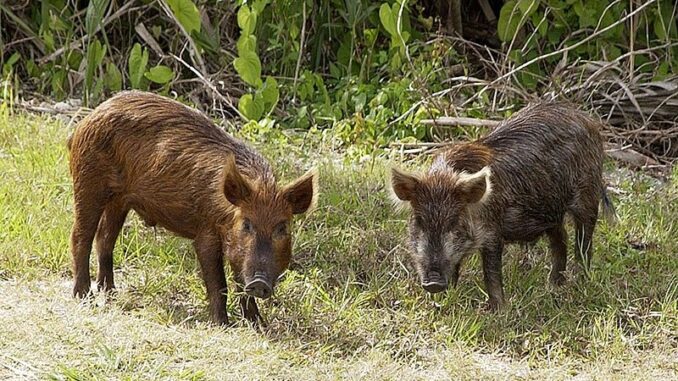
In the last few decades, the feral hog population in the United States has exploded completely out of control. Once limited primarily to the southeastern states, wild pigs now call all fifty states home, and several Canadian provinces, too. Each state makes their own estimates of the feral population within their borders, with minimum and maximum numbers. Those estimates form the basis of the national estimate. The highest numbers are still primarily in the southeast, although California has become overrun as well. Since estimates are only estimates, no one really knows how many wild pigs inhabit the U.S., but four million may be the lower end and nine million the upper reach. Female hogs typically have one or two litters of piglets a year, averaging four or five piglets each litter. If each female has ten piglets annually, it’s easy to understand the rapid growth of the feral hog population. One million pigs could become ten million pigs in just one year! Of course that doesn’t consider mortality rates, but you get the idea.
The picture above appears to show two juvenile animals. Adult hogs are bigger and usually have large, sharp tusks that can kill a human being. I’ve seen them as tall as my waist, and that’s probably just an average size. They can run unbelievably fast when they’re motivated: shoot at them and prepare to be amazed.
Feral hogs cost Americans as much as $2.5 billion dollars annually in terms of property damage and control efforts. They destroy crops, pastures, fencing, landscaping, and more. They carry more than thirty different diseases which can infect other wildlife, livestock, and even humans. Hogs also wreak havoc on ecosystems and wildlife habitats, kill other animals for food (they’ll eat just about anything), and have even been known to kill humans. They are a dangerous, highly destructive, invasive species that were brought here from Europe. Irradication efforts have been anything but succesful. Trapping, hunting, shooting at the hogs from helicopters and even from hot air balloons have all yielded insufficient, if not disappointing, returns. No matter how many are killed or captured, the populations continue to grow.
A completely new strategy shows promise: feed them contraceptives! Initiated this summer, the food made by HogStop contains a proprietary blend of common livestock feed ingredients that reduce sperm motility in hogs by 60% and also reportedly causes changes to sperm morphology (i.e., form and structure), further reducing the efficacy of the male reproductive capability. The US Environmental Protection Agency has approved the product and designated it as an ‘25 (b)’ pesticide. Because HogStop can impact other animals if consumed, the company provides a recommended list of feeders and instructions outlining ways to keep other wildlife from eating the product. Sounds promising. Remember, contraception helps prevent the conception of little piggies.
Suuu-wheee!
Question Of The Night: What did you have for dinner, and how was it?
